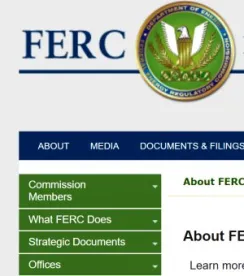On November 18, 2021, the Federal Energy Regulatory Commission (FERC or Commission) issued a Notice of Inquiry (NOI), seeking comment on issues related to reactive power capability compensation.
Specifically, the Commission is seeking comments on:
-
various aspects of the AEP Methodology-based compensation;
-
potential alternative methodologies for calculating reactive power compensation; and
-
reactive power capability compensation through transmission rates for resources that interconnect at the distribution level.
Initial comments are due 60 days after the NOI has been published in the Federal Register and reply comments are due 90 days after the initial comment deadline.
The NOI represents a step towards the potential of greater certainty regarding reactive power compensation.
Background
Reactive power is a critical ancillary service provided by generation and non-generation resources on a transmission system to facilitate the long-distance transmission of real power, and to support system voltages and help ensure reliability of the transmission grid. Costs for reactive power supplied using generation resources are recovered separately from the cost of basic transmission service.
In 1999, the Commission approved a method, now referred to as the AEP Methodology, for American Electric Power Service Corp., a public utility that abided by the Commission’s Uniform System of Accounts and annually submitted a FERC Form No. 1, seeking to recover costs for the reactive power its synchronous generators provided. (See Opinion No. 440, 88 FERC ¶ 61,141.) Subsequently, the Commission has recommended, though never required, use of the AEP Methodology, nor required any other uniform approach for reactive power capability compensation. Since 1999, the electric industry has undergone significant changes—today, the majority of the reactive power filings submitted to the Commission are made by owners of non-synchronous resources and many filing entities have received waivers of the requirement to maintain their accounts under the Uniform System of Accounts rules and to file FERC Form No. 1.
FERC Seeks Comment on Reactive Power Capability Compensation and Market Design Topics
The NOI seeks comment on three overarching categories of issues and poses specific questions within each category. Below are the three categories, including a summary of some of the more significant questions asked in each category.
1. Is the AEP Methodology a just and reasonable approach in all circumstances?
The Commission asked commenters to address whether various aspects of the AEP methodology are still appropriate; to consider resources whose reactive power requirements are not addressed in the resource’s interconnection agreement; and to explain why parties other than the market monitor and RTO/ISO generally do not participate in reactive power filings set for hearing and settlement judge procedures. The Commission also asked for comments on the following topics:
a) Degradation: FERC asked about how a resource’s reactive power capability degrades over time, whether periodic reactive power capability testing should be required and whether the AEP methodology should be modified to account for reactive power capability degradation over the lifetime of the resource.
b) Non-synchronous Resources: FERC asked whether the existing AEP Methodology can be appropriately applied to reactive power capability compensation for non-synchronous resources, including what non-synchronous resource equipment corresponds to the synchronous resource equipment used in the AEP Methodology and how the costs associated with the collection system of non-synchronous resources correspond with how costs are assigned under the AEP Methodology. The Commission also asked how the intermittent availability of such non-synchronous resources should be accounted for.
c) Evidentiary Support at FERC: Acknowledging that many filing entities have received waivers of the requirement to maintain their accounts under the Uniform System of Accounts rules and to file FERC Form No. 1, the Commission asked how to collect independently verifiable cost information from such filing entities. Specific to PJM, MISO, and non-RTO/ISOs that compensate for reactive power capability based on the costs of individual resources or on a fleet-wide basis, the Commission asks if filers in such regions should be required to submit with their compensation filing, a standardized form with recognized schedules and officer and independent accountant certification requirements.
d) Potential Overcompensation in PJM: FERC seeks comment on the PJM Market Monitors concerns about the potential in PJM for double recovery or overpayment for reactive power capability.
2. Potential Alternatives to the AEP Methodology
FERC sought comment on alternatives to the AEP Methodology, taking into account different resource types. FERC asked about existing compensation approaches including flat rate and replacement cost approaches. Noting that in CAISO and SPP, resources are not directly compensated for reactive power capability, FERC asked how these resources recover their costs. FERC also asked if it would be preferable in regions with a centrally-cleared capacity market for reactive power capability compensation to be recovered by embedding costs in the resources capacity market offers, rather than to use a separate cost-based rate.
3. Should resources that are interconnected to a distribution system and participate in wholesale markets be eligible for reactive power capability compensation?
FERC asks about distribution-connected resources: whether they are dispatchable by direction of the transmission provider to provide voltage support and whether they should be compensated for reactive power capability. FERC also asked if such resources are subject to reactive power capability testing requirements.
Analysis
In the last six years FERC has set nearly all reactive rate filings for hearing and settlement procedures with little guidance or directive for the participants on the issues for resolution. With no certainty in how to adapt a methodology meant for synchronous generators who abide by the FERC System of Accounts and file FERC Form No. 1’s, reactive rate filers are forced to either settle at drastically reduced rates or submit to potentially protracted litigation. Understandably, the vast majority of filers have opted to resolve their cases with non-precedential black box settlements. The inconsistent results in these cases have left the industry with uncertainty regarding rate recovery for reactive service capability.
FERC’s NOI provides a step towards the potential of greater certainty regarding reactive power. The Commission’s apparent openness to reevaluating its current inconsistent and sub-optimal approach is a positive development for owners of generation with reactive power capability. A rulemaking that establishes certainty could greatly reduce the number of proposed reactive power rate schedules set for hearing procedures, bring an end to what is often costly and protracted settlement negotiations, and may allow for reactive rate filers to earn more representative rates.





 />i
/>i

